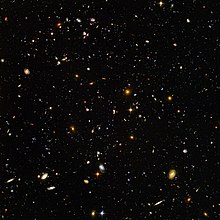 |
The Big Bang theory is the prevailing cosmological model that explains the early development of the Universe. According to the Big Bang theory, the Universe was once in an extremely hot and dense state which expanded rapidly. This rapid expansion caused the young Universe to cool and resulted in its present continuously expanding state. According to the most recent measurements and observations, this original state existed approximately 13.7 billion years ago, which is considered the age of the Universe and the time the Big Bang occurred.After its initial expansion from a singularity, the Universe cooled sufficiently to allow energy to be converted into various subatomic particles. It would take thousands of years for some of these particles (protons, neutrons, and electrons) to combine and form atoms, the building blocks of matter. The first element produced was hydrogen, along with traces of helium and lithium. Eventually, clouds of hydrogen would coalesce through gravity to form stars, and the heavier elements would be synthesized either within stars or during supernovae.
Edwin Hubble proposed the Big Bang Theory.Time Line:
 The earliest phases of the Big Bang are subject to much speculation. In the most common models the Universe was filled homogeneously and isotropically with an incredibly high energy density and huge temperatures and pressures and was very rapidly expanding and cooling. Approximately 10−37 seconds into the expansion, a phase transition caused a cosmic inflation, during which the Universe grew exponentially. After inflation stopped, the Universe consisted of a quark–gluon plasma, as well as all other elementary particles.Temperatures were so high that the random motions of particles were at relativistic speeds, and particle–antiparticle pairs of all kinds were being continuously created and destroyed in collisions. At some point an unknown reaction called baryogenesis violated the conservation of baryon number, leading to a very small excess of quarks and leptons over antiquarks and anti-leptons—of the order of one part in 30 million. This resulted in the predominance of matter over antimatter in the present Universe.
The earliest phases of the Big Bang are subject to much speculation. In the most common models the Universe was filled homogeneously and isotropically with an incredibly high energy density and huge temperatures and pressures and was very rapidly expanding and cooling. Approximately 10−37 seconds into the expansion, a phase transition caused a cosmic inflation, during which the Universe grew exponentially. After inflation stopped, the Universe consisted of a quark–gluon plasma, as well as all other elementary particles.Temperatures were so high that the random motions of particles were at relativistic speeds, and particle–antiparticle pairs of all kinds were being continuously created and destroyed in collisions. At some point an unknown reaction called baryogenesis violated the conservation of baryon number, leading to a very small excess of quarks and leptons over antiquarks and anti-leptons—of the order of one part in 30 million. This resulted in the predominance of matter over antimatter in the present Universe.
A few minutes into the expansion, when the temperature was about a billion (one thousand million; 109; SI prefix giga-) kelvin and the density was about that of air, neutrons combined with protons to form the Universe's deuterium and helium nuclei in a process called Big Bang nucleosynthesis. Most protons remained uncombined as hydrogen nuclei. As the Universe cooled, the rest mass energy density of matter came to gravitationally dominate that of the photon radiation. After about 379,000 years the electrons and nuclei combined into atoms (mostly hydrogen); hence the radiation decoupled from matter and continued through space largely unimpeded. This relic radiation is known as the cosmic microwave background radiation or CMB.





0 comments:
Post a Comment